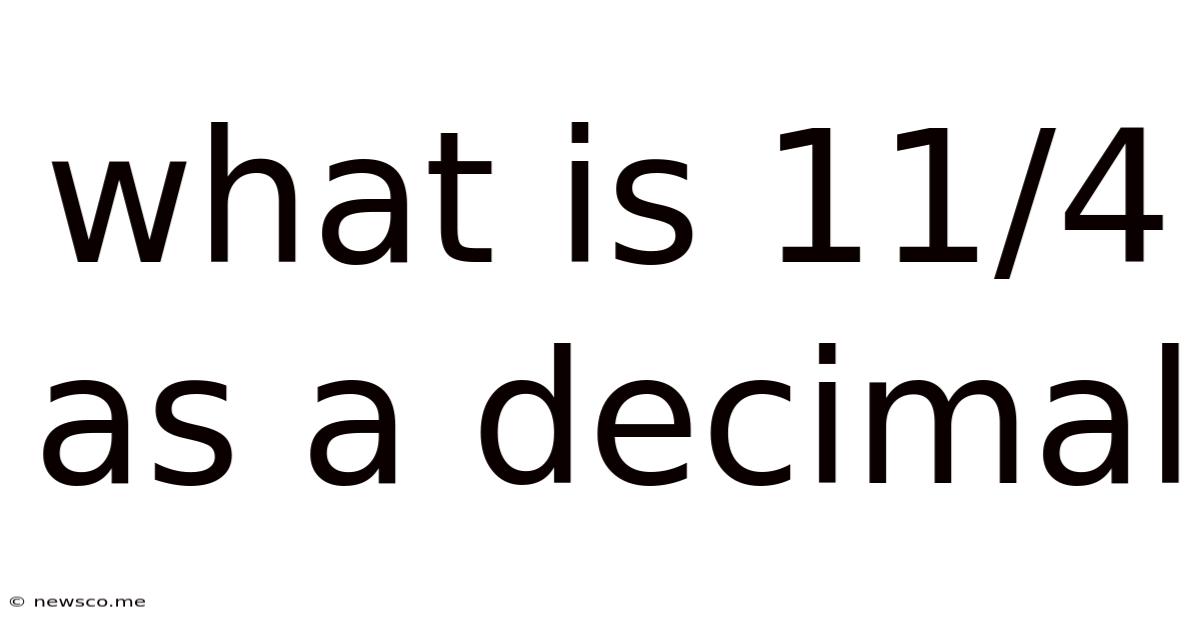What Is 11/4 As A Decimal
News Co
May 08, 2025 · 4 min read

Table of Contents
What is 11/4 as a Decimal? A Comprehensive Guide
Knowing how to convert fractions to decimals is a fundamental skill in mathematics, applicable in various fields from everyday calculations to advanced scientific computations. This comprehensive guide delves into the conversion of the fraction 11/4 into its decimal equivalent, exploring multiple methods and providing a deeper understanding of the underlying principles. We'll also touch upon practical applications and related concepts to solidify your understanding.
Understanding Fractions and Decimals
Before we jump into converting 11/4, let's briefly review the basics of fractions and decimals.
A fraction represents a part of a whole. It consists of two parts: the numerator (the top number) and the denominator (the bottom number). The numerator indicates how many parts you have, and the denominator indicates how many equal parts the whole is divided into. For example, in the fraction 11/4, 11 is the numerator and 4 is the denominator.
A decimal is another way to represent a part of a whole. It uses a base-10 system, with digits to the right of the decimal point representing tenths, hundredths, thousandths, and so on. For instance, 0.5 represents five-tenths, and 0.25 represents twenty-five-hundredths.
Method 1: Long Division
The most straightforward method to convert a fraction to a decimal is through long division. We divide the numerator by the denominator.
In our case, we need to divide 11 by 4:
2.75
4 | 11.00
-8
30
-28
20
-20
0
Therefore, 11/4 as a decimal is 2.75.
Method 2: Converting to a Mixed Number
Sometimes, it's easier to convert an improper fraction (where the numerator is larger than the denominator) to a mixed number first, and then convert the fractional part to a decimal.
An improper fraction is a fraction where the numerator is greater than or equal to the denominator. A mixed number combines a whole number and a proper fraction.
To convert 11/4 to a mixed number, we perform division:
11 ÷ 4 = 2 with a remainder of 3.
This means 11/4 can be written as the mixed number 2 3/4.
Now, we convert the fractional part (3/4) to a decimal:
3 ÷ 4 = 0.75
Adding the whole number part, we get 2 + 0.75 = 2.75.
Method 3: Using Equivalent Fractions
Another approach involves finding an equivalent fraction with a denominator that is a power of 10 (10, 100, 1000, etc.). This makes the conversion to a decimal straightforward.
However, in the case of 11/4, finding an equivalent fraction with a denominator that's a power of 10 isn't immediately obvious. While this method works well for fractions with denominators like 2, 4, 5, 8, and 25, it's less efficient for 11/4.
Understanding the Decimal Result: 2.75
The decimal 2.75 represents two whole units and seventy-five hundredths of another unit. You can visualize this as two whole objects and three-quarters of a third object. This is consistent with our mixed number representation, 2 ¾.
Practical Applications
The ability to convert fractions to decimals has widespread practical applications:
- Finance: Calculating percentages, interest rates, and proportions of money.
- Measurement: Converting units of measurement, such as inches to centimeters or pounds to kilograms. Many conversion factors are fractional.
- Science: Representing experimental data and performing calculations in various scientific fields.
- Engineering: Designing and building structures, calculating forces, and working with dimensions.
- Cooking and Baking: Following recipes that require precise measurements.
Related Concepts and Further Exploration
This section explores related mathematical concepts that build upon the understanding of fraction-to-decimal conversions:
- Recurring Decimals: Some fractions, when converted to decimals, result in non-terminating, repeating decimals (e.g., 1/3 = 0.333...). 11/4, however, results in a terminating decimal.
- Percentage Conversions: Decimals and fractions can easily be converted to percentages by multiplying by 100 and adding a % sign (e.g., 0.75 = 75%). This is crucial for understanding proportions and ratios.
- Scientific Notation: For very large or very small numbers, scientific notation (e.g., 2.75 x 10¹ for 27.5) is employed.
- Significant Figures: When dealing with measurements, understanding significant figures is important to maintain accuracy during calculations and conversions.
Conclusion: Mastering Fraction-to-Decimal Conversions
Converting 11/4 to its decimal equivalent, 2.75, is a simple yet crucial skill in mathematics. Understanding the different methods – long division, converting to a mixed number, and (where applicable) using equivalent fractions – allows for flexibility and efficiency in various situations. The ability to perform this conversion is vital for a wide range of practical applications, from everyday calculations to more complex scientific and engineering problems. Remember to practice regularly to solidify your understanding and improve your speed and accuracy. By mastering this fundamental concept, you'll build a strong foundation for more advanced mathematical concepts and problem-solving. The practical applications are vast, making this skill an invaluable asset in numerous fields.
Latest Posts
Latest Posts
-
What Is A Triangle With 2 Equal Sides
May 08, 2025
-
What Is The Absolute Value Of 10
May 08, 2025
-
Adding Subtracting Multiplying Dividing Fractions Worksheet
May 08, 2025
-
What Is The Prime Factorization Of 375
May 08, 2025
-
How Do You Find The Perimeter Of An Octagon
May 08, 2025
Related Post
Thank you for visiting our website which covers about What Is 11/4 As A Decimal . We hope the information provided has been useful to you. Feel free to contact us if you have any questions or need further assistance. See you next time and don't miss to bookmark.